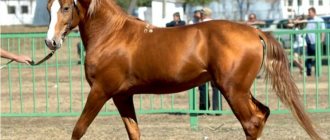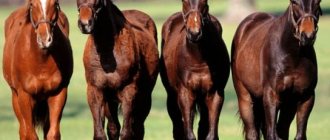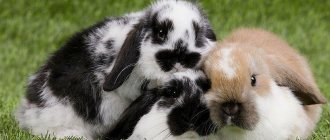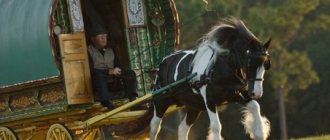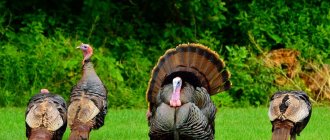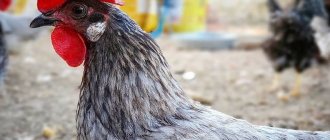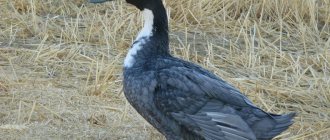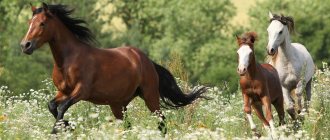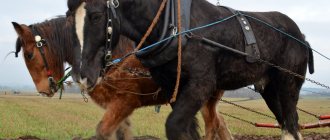The Trakehner horse is named after the Austrian village of Trakehner, where the stud farm where this breed was bred for a long time was located. Prussia 18th century needed good cavalry horses, and she got them after many years of selecting sires and selecting individuals for the desired characteristics.
Character
If we take into account the fact that Trakehnens were originally bred for military needs, then it becomes clear where such traits as determination, perseverance and hot temper come from in their character.
But, besides this, the character of this species is harmoniously complemented by humility, swiftness, patience, the ability to adapt to environmental conditions, and strength. You can even talk about the nobility and intelligence of these horses... Did you know? Trakehner horses are even used for medical purposes.
They are perfect for hippotherapy sessions.
Did you know? Trakehner horses are even used for medical purposes. They are perfect for hippotherapy sessions.
Scope of application
Due to their excellent physical characteristics and fairly docile nature, Trakehner horses are used in cavalry, equestrian sports, where they show fairly good results, as well as in horse riding and even agriculture. These horses are easy to train and train.
Advantages and disadvantages
Trakehner horses have both advantages and disadvantages. Among the advantages it is worth noting:
- versatility - this refers to the comprehensiveness of their use;
- high efficiency and tirelessness;
- light and smooth movements, which is especially valued in hippotherapy;
- the ability to jump high - this allows horses of this breed to win championships in various equestrian sporting competitions;
- attractive and representative exterior;
- balance of character;
- fearlessness and willingness to take risks;
- ease of training.
Important! Trakehner horses live on average 30–35 years. At 2 years of age they reach puberty
But in order to get healthy offspring, horse breeders recommend waiting until the horse is 4 years old.
Let's also consider the disadvantages of the breed:
- Trakehnens are quite capricious and spoiled. Such traits mostly relate to grooming. The fact is that in the process of breeding work, the horses were provided with the best living conditions, while little attention was paid to their training and physical work.
- It is quite difficult to breed them in a herd, since they have, compared to other breeds, weak immunity and can easily catch infectious or colds. It is best to breed them in separate stables with summer grazing.
- Of 100% of foals born, about 85% survive, which is also explained by a weak immune system and low viability.
- These horses often suffer from hernias and joint diseases.
Price
Buying a traken will cost a farmer from 2 to 10 thousand dollars.
The reason for this is that it is an elite breed. The cost of an animal directly depends on age, gender, health, sporting achievements and pedigree.
For example, sick or old specimens will cost less - about $1,000. Young horses without pedigree or athletic training sell for between $3,000 and $6,000.
The most expensive are considered to be young, strong and healthy horses with athletic training and a noble pedigree. In many ways, the cost of an animal depends on who its parents are and what achievements they have behind them.
Sports career of the Trakehner horse breed
Although the Trakehners were among some of the best horses, the breeding work on the breed did not end there. In order for the horse to take prizes at the races, the blood of thoroughbred horses was added to it. The latter were distinguished not only by their sporting qualities, but also by their repeated victories in equestrian competitions.
The Trakehne breed today is a sport horse, excellent for riders of any skill level.
After improving its characteristics, the Trakehner horse breed was able to become a winner at the Olympic Games, more than once. As a small example, a gelding named Peccolini won a gold medal in dressage in 1921.
Trakehner victories were also noticed at the following competitions:
- in Paris (1924) - the winner was a gelding called Balte, participating in eventing;
- in Berlin (1936) - this year became a triumph for all Trakehner horses, since it was this type of horse that became the undisputed winner in all possible disciplines related to equestrian sports;
- in the Greater Pardubice Steeplechase (during the entire period from 1921 to 1936) - one stallion Vityaz especially distinguished himself in these competitions, who later turned out to be a five-time winner.
When World War II came, the situation with the breeding of these horses changed dramatically. In 1945, the Trakehner breed ended up on the territory of the Rostov region, or more precisely at the stud farm named after. Kirov. In this place they were able to collect the best individuals of the Trakehner breed. Proof of the effective work of Soviet breeders were the most honorable places at horse races taking place in the 60s.
However, despite such remarkable results, the Trakehners began to die very quickly. The reason for such a high mortality rate was due to several factors:
- the presence and maintenance of horses in conditions atypical for them;
- lack of certain knowledge among breeders regarding the gene pool of the Prussian breed;
- ignorance of the nature of some diseases inherent only to the Trakehner breed of horses.
To save the livestock, the breeder had to bring several individuals from Prussia, bred for harnessing into carriages. This helped refresh the gene pool of the breed, but the purity of the stallions brought from abroad was also not in its original form. As a result of such actions, the quality of the Trakehner, as a workhorse, sharply decreased.
Trakehner horses, born in Russia, have proven themselves well in equestrian sports and are listed as a separate line in all ratings under the name “Russian Trakehner”.
In the 70s of the last century, breeding of this breed began again, but in other institutions. Already in 1974, the first edition of the studbook of the Trakehner breed of national importance was compiled. Even such an unusual term as “Russian traken” has appeared in the world.
Subsequently, breeders could restore the sporting qualities of this breed. For example, in 1972, a stallion named Ash was able to take second place at the Olympic Games. Before him, the sports horse Ichor was also able to win, and also at the Olympic Games. The next Olympians can be considered horses named Topkiy and Espadron, who were able to take pride of place at the 1980 Moscow Olympics.
This list can be enumerated endlessly: the most important thing is that the Trakehners were completely restored by breeders as a separate and unique breed.
- Kurilian Bobtail: breed characteristics, care and maintenance
- Features of horse care: feeding, maintenance
Content
In order for Trakehner horses to feel great, to be strong, strong and healthy, and to show good results in competitions, they need to be provided with proper care:
- Clean the stables and stalls. Cleaning is carried out regularly. Once a month, the premises are treated with antiseptic agents against pests and parasites.
- Make sure there are no drafts in the room. Horses do not tolerate excessive dryness, high humidity and windiness - this can lead to diseases.
- Equip feeders and drinking bowls. They should always have clean drinking water and fresh food.
- Provide long walks. Due to the fact that Trakens are active animals, they need long-term walking, for which they use large pastures so that the horses have the opportunity to frolic to their heart's content.
- Regularly brush and bathe horses. These procedures help maintain an attractive appearance. Once a week you need to wash your horses with special hair and mane care products. In summer this should be done more often.
Competition horses require training and exercise on a daily basis. If training is irregular, this may cause the horses to not be strong and resilient enough.
Trakens. Trakehner horse breed
Trakehner horses are a draft horse breed that was developed in East Prussia at the end of the 18th century. The Trakehner breed is the only warm-blooded breed that is bred in purity. Trakehner horses have much in common with the thoroughbred riding breed. For the last 30 years, representatives of the Trakehner breed have been actively used in equestrian sports, in particular in eventing. Previously, they were known as first-class cavalry horses. Trakehner horses are also popular among breeders.
Main characteristics of the breed
Height on average is from 1.62 to 1.68 m.
Color: black, bay, red. Less often – gray.
Exterior: dry, light head, merging into a conical, elegant neck. Large expressive eyes. Trakehner horses have a powerful body of medium length and a wide chest. The shoulders are set obliquely, the croup has an oval shape. Solid legs are topped with beautiful, strong hooves.
Uses: Trakehner horses were used in agriculture. In addition, they were excellent cavalry horses. In the last 30 years they have become widespread in equestrian sports. Breeders also use representatives of the Trakehner breed in their work.
Features: Trakehners are distinguished by their perfect head shape. In addition, Trakehner horses are distinguished by the elegant lines of the body, which they owe to the thoroughbred. Trakehner horses are renowned for their endurance, which helped them survive the hardships of World War II. Thanks to their endurance, the Trakehner are ideally suited for eventing and carriage racing.
History of the breed
The origin of the Trakehner breed dates back to 1732, when a stud farm with one and a half thousand livestock was opened in the East Prussian village of Trakehner (the land of modern Germany) under the leadership of Frederick I.
Although the history of the Traken, in fact, begins much earlier - back during the colonization of Prussia by the Teutonic Order, when the knights were breeding new horses, universal both in harness and in riding.
The numerous military campaigns at that time put forward new requirements for horses, which had to be strong enough, hardy and fast. To satisfy these goals, heavy knightly and light eastern stallions were crossed with Zhmud mares.
As a result, by the middle of the 15th century, the Teutonic Order already had more than three dozen stud farms with a total population of almost 15 thousand draft and riding hardy horses.
By the time Frederick I ascended the throne, the Prussian state needed strong cavalry. Therefore, the ruler created the first royal stud farm in Trakehner, which was supposed to provide the cavalry with strong and strong horses.
The Trakehner plant began to function in two directions - the creation of riding horses for the army and strong working horses for agricultural land.
At first, small forest mares and brave eastern stallions were used for breeding - Persian and Turkish, Arabian and Barbary, Spanish and Neapolitan; for these purposes they even brought two Don stallions. A little later they were joined by representatives of the English breed.
Video: all about the Trakehner horse breed By the end of the 19th century, stallions of purebred riding and Arabian breeds were recognized as the best for breeding.
Mixing of half-blooded individuals was also allowed, but they had to meet the basic requirements:
- large sizes;
- high growth;
- long body;
- long and straight neck;
- strong legs;
- flexible character.
From the second half of the 19th century, horses bred in Trakehner already met these requirements. Stallions began to be actively used in sports competitions - flat racing, steeplechase, parforce hunts, dressage, show jumping, eventing, and mares were used for agricultural purposes.
Thus, the thoroughbred, massive and hardy Trakehner horse was created. This breed has gone down in history as one of the most sought after in equestrian sports.
Throughout the 20th century, trakens took prizes in many competitions. At factories, horses of this breed were necessarily branded in the area of the left thigh with a sign in the form of a seven-pointed elk horn.
Over the course of their history, trakens have been on the verge of extinction. During the Second World War, during the evacuation of horses from Germany to Western Europe, most of the individuals died. No more than a thousand horses reached their destination.
By the middle of the 20th century, the livestock was record small - only about 50 stallions and 600 mares. The breed was saved from extinction only thanks to enthusiastic breeders who set themselves the goal of preserving the Traken.
Since 1960, the Trakehner horse began to be bred purely and was reclassified by German horse breeders from cavalry to sports.
Trakehnens are susceptible to three genetic disorders:
- Cerebellar abiotrophy is a neurological disease that usually affects foals before six months of age. Affected foals are at increased risk of accidents and should not be ridden.
- Severe combined immunodeficiency syndrome affects two types of white blood cells in foals. Affected foals may experience symptoms such as pneumonia, colic and weight loss, and usually die within the first six months of life.
- Lavender foal syndrome is an inherited disorder that causes neurological problems such as seizures, hypertensive limbs, and paddling movements of the legs. This condition is fatal.
All these disorders can be detected using DNA analysis.
History of the Trakehner horse breed
A stud farm was opened in the village of Trakehnen (East Prussia) in 1732. At that time, the main task of the stud farm was to provide the Prussian cavalry with magnificent horses: hardy, unpretentious, but at the same time playful.
The creation of the breed involved Schweiks (local forest-type horses), Spanish, Arabian, Barbary and purebred English horses. They even brought two Don stallions.
However, in the middle of the 19th century, it was decided to allow only Arabian, thoroughbred riding horses and their crosses to participate in the breeding of Trakehner horses. The stallions had to meet a number of requirements:
- a big increase
- long body
- strong legs
- long straight neck
- productive movements
- goodness.
The stallions' trials included first smooth racing, and then parthos hunts and steeplechases. The tests of the mares consisted of transport and agricultural work.
As a result, in the 20th century it was possible to create a large, massive, but at the same time quite elegant horse, which began to gain popularity throughout the world.
However, World War II brought the Trakehner horse to the brink of extinction. Many horses died during the evacuation to Western European countries or were expropriated by Soviet troops.
Despite this, after the war the number of Trakehner horses began to grow thanks to the efforts of enthusiasts.
In the 60s of the 20th century, German horse breeders decided to “retrain” Trakehner horses. They exchanged their “job” in the cavalry for a sports “career”. And they have proven themselves excellent in show jumping, dressage and eventing. This led to an increase in interest in the breed, which at that time was already bred in purity.
In the photo: Trakehner horse
What is the tracken used for?
In the modern era, the Trakehner horse breed is used in sports. But, besides sports, due to their calm nature and high physical performance, geldings are also used in other areas of activity. Such a horse is an ideal assistant; it was for these purposes that horses were created.
Trakehner horses take part in various sporting competitions. They very often achieve success and take first place. From the point of view of many horse lovers and Traken fans, geldings are especially different from their counterparts due to their incredibly light gait. The animals have long legs and take long steps when running rhythmically, which means they are faster than most breeds.
Horses have been used in rural industries for many centuries. It is not difficult for animals to complete this or that task, since they can concentrate on the goal, and their excellent physical characteristics allow them to carry heavy loads without problems. These skills make Trakens versatile, graceful, and strong. They easily perform long-term physical activity, heavy work and are ideal for riding.
Usage
These horses are most valued for their athletic achievements. In addition, they are a decoration for home stables. Agriculture now no longer has a great need for draft horsepower. However, Trakehners have proven themselves well as a vehicle where it is not possible to travel by car.
They are successfully used for expeditions and tourist excursions in the mountains. With proper training, they can be recruited to work in mounted police and border troops.
History of selection
The selection of Trakehner horses changed its purpose several times and in some periods was on the verge of extinction:
- In the 18th century, horses were used exclusively for royal carriages and for royal hunting.
- In the 19th century, cavalry officers of the German army rode Trakehner horses.
- At the beginning of the 20th century, representatives of the breed took part in sports competitions and were bred precisely for this purpose. At the Olympics in Berlin in 1936, all the prizes in equestrian sports were occupied by Traken.
- The Second World War seriously undermined the breeding of these horses in Germany. Before the Soviet army entered Germany, the Germans released the remaining 1,200 Trakens from the stables into the wild so that they would not fall to the Russians. At this time the breed was on the verge of extinction.
- The breeding farm in Trakehner was completely destroyed by military action. The horses were taken to the Soviet Union, where they had no breeding value. There was no talk of preserving them for further selection.
- In 1948, the Union of Horse Breeders and Friends of the Trakehner Horse was founded in Germany, which restored the right to mark high-quality representatives of the breed with a brand with the image of a double elk horn. The organization's activities were aimed at preserving the breed and its further selection.
- In Russia, the breeding of Trakehner horses began in 1945, when trophy horses arrived in the country after the war. Their condition was exhausted, many died from disease. They were transported to the Rostov region to the horse breeding plant named after. Kirov, who took up breeding work under the supervision of a great connoisseur and horse lover, Marshal S. Budyonny.
- In the 60s of the 20th century, a decision was made regarding the purpose of the breed: exclusively sporting. After this event, breeders in different countries became interested in breeding Trakens.
- During the reign of N.S. Khrushchev, cavalry as a branch of the army in the active army was abolished, and the livestock of many breeding plants was slaughtered for the food industry. During that period, the Trakens were again in danger of extinction.
- Currently, the breed both in Germany and Russia continues to develop and improve. Thanks to breeding work, horses successfully participate in sporting competitions and are becoming increasingly popular among individual breeders.
general characteristics
The elegant and attractive exterior makes the Trakehner a real find for breeders. But at the same time, in order to preserve the purity of the breed and procreation, in some countries, in particular in Germany, incest is not allowed, and mating occurs only with stallions of a given breed.
External features
Trakehner can be easily distinguished from other horses if you carefully study the features of its exterior:
- the height of the horse at the withers can reach 165 cm, and the length of its body - 168 cm;
- The chest of a horse of this breed is quite wide and powerful, the chest girth of an adult horse reaches 196 cm;
- Trakehner can have black, bay, gray, red and even karak or roan color;
- these horses are distinguished by a rather large head with a wide forehead and large expressive eyes;
- the neck of the Trakehner horse is cone-shaped and quite long;
- Trakehnens differ in weight, which ranges from 460–550 kg;
- The exterior features of this breed also include powerful, slightly obliquely set shoulder blades;
- the legs of these horses are muscular, well set and physically developed, which can explain their grace, energy, speed and endurance;
- The hooves have a regular oval shape with a well-defined hoof horn.
Important! Among the special features of the Trakehner horse breed is a mark in the form of seven-pointed elk antlers, which is usually applied to the left thigh
Feeding
Nutrition of the Trakehner horse breed is a separate topic. In this case, it is important to follow the basic recommendations:
- Despite the fact that horses of this breed are predominantly large in size, they have a small stomach. For this reason, they need frequent feeding, but in small portions.
- It is required to regularly ensure that animals have clean water and drinking utensils. It needs to be washed after every meal.
- To satisfy the chewing abilities of horses and the proper functioning of the gastrointestinal tract, it is imperative to include forage in the diet.
- A new product should be introduced into the horse’s diet gradually. This is how the stomach gets used to an unusual dish.
- Give animals only high-quality feed. Do not feed horses foods that form mold, as this can lead to infection with infectious diseases.
- The diet is prepared based on physical activity.
- After eating, horses need rest - this promotes better digestion of food. You cannot immediately load horses with physical activity.
To maintain the health of Trakehner horses, it is necessary to regularly examine them, paying attention to the genital cavity.
The farmer will need to brush the horses’ teeth, file down pointed specimens, and feed the animals with remedies against worms and other parasitic microorganisms.
Be sure to contact a veterinarian if you notice that the horse’s behavior has changed significantly and his health has worsened.
Vaccinations
Animals must be examined and vaccinated by a veterinarian twice a year:
- After returning from summer pastures.
- Before going out to spring pastures.
Recommended vaccinations:
- from anthrax;
- from dermatophytoses;
- against flu;
- against leptospirosis;
- from rabies;
- from tetanus.
Disease Prevention
In order for the horse to get sick less, it is necessary to take certain preventive measures, which are presented:
- regular cleaning of the premises and daily change of bedding to avoid the development of harmful microorganisms;
- regular nutrition and observance of feeding frequency;
- monthly examination by a veterinarian to identify possible health problems and provide timely treatment;
- providing individuals with complex supplements, in the form of a vitamin and mineral complex to enhance immunity;
- maintaining the hygiene of horses, regularly bathing them, caring for hooves, teeth and fur;
- timely vaccination as recommended by a veterinarian;
- using high-quality feed, previously checked for the presence of foreign objects, impurities of dangerous plants, rodent excrement, traces of rot, mold;
- ensuring quiet rest at night and regular breaks during difficult work;
- maintaining the required microclimate in the room where the horses live.
Trakehner breed in Russia
Brand name
The average sizes of Russian Trakehner stallions are 167 - 195 - 21 cm, Russian Trakehner mares are 163 - 192 - 20 cm. The pride of Russian equestrian sport, Ash helped his rider Elena Petushkova win many titles.
A considerable number of Russian Trakehner are sold abroad and there they achieve success in show jumping, dressage and classical disciplines. Outstanding dynasties of domestic Trakehner horses are recognized in different parts of the globe.
In Russia, Trakehner are bred in several stud farms in the country. This breed has not only established itself well here, but has also gained fame for many years.
Breeding prospects
Currently, the Trakehner horse, as the only racing breed without the admixture of foreign blood, is bred in Germany.
There are about 2.5 thousand mares and 300 stallions in this country. The breed is also bred in other countries, among them: France, Denmark, USA, Poland, New Zealand, England, Croatia, Russia.
We can conclude that the prospects for the Trakehner breed are quite good; its demand is primarily due to its good physical characteristics, which allow the universal use of horses.
History of the breed
The Trakehner horse breed was developed in Prussia. In 1232, the knights of the Teutonic Order began colonizing Prussian lands. Due to numerous military campaigns, the need arose for hardy and strong horses. Then the knights of the Order began creating a new breed, crossing Zhmud mares with light eastern and heavy knightly stallions brought from the Crusades. By 1400, the Teutonic Order had more than thirty stud farms at its disposal, in which large draft and draft horses were bred with a total of 14,000 heads. In 1701, Frederick the First ascended to the throne of Prussia. In those days, the state felt the need for strong cavalry. For this purpose, a royal stud farm was created in 1732 in the east of the country. This year became the official year of birth of the Trakehner breed. To staff the plant, 1,101 horses were purchased, mainly of English, Danish and Oriental breeds. Horses were bred in 2 main areas: draft horses for agriculture and carriages, and riding horses for the army. The Trakehner factory supplied horses for the army cavalry and court stables. Trakehner horses have proven themselves excellent in harnesses - they covered the distance from Berlin to Potsdam in just 2 hours, 30 minutes ahead of Mecklenburg, English and Russian horses. Since 1787, all riding horses born in Trakehner received a brand on the right hip in the form of a 7-pointed elk horn. The Trakehner stud had a significant influence on the development of horse breeding in the country. By the end of the 19th century, Trakehner blood was present in the veins of every horse in Prussia. In 1890, a studbook for East Prussian horses was created. At the beginning of the twentieth century, due to the demilitarization of Germany and the mechanization of agriculture, priorities in breeding Trakehner horses were significantly shifted. The market needed large, noble and elegant horses for the rapidly growing popularity of equestrian sports and the local aristocracy. At that time, the Treken breed was one of the best sporting breeds in the world. Thoroughbred stallions, repeated winners of prestigious races, were purchased for the production team for subsequent use in breeding work.
Before the outbreak of World War II, Trakehner horses repeatedly became medalists and winners of the Olympic Games. In 1912, in Copenhagen, the gelding Peccolini took gold in dressage. In 1924 in Paris, the gelding Balte also became the Olympic champion in eventing. In Berlin in 1936, the German team on Trakehner horses won brilliant victories in all equestrian disciplines - this year was truly triumphant for the Trakehner horses. Trakehner horses also occupied consistently high places in the Greater Pardubice Steeplechase from 1921 to 1936. In particular, the stallion Vityaz took prizes 5 times in Pardubice. The Second World War was a turning point in the history of the Trakehner breed. In 1945, the Trakehners came to the USSR, to the Kirov stud farm, located in the Rostov region. These were the best of the breed. Horses that were born during these years took the highest places in the races in the early 60s. However, the Trakehner horses had a hard time in their new homeland. Due to atypical conditions of detention, ignorance of the gene pool and diseases, part of the livestock died.
In order to “refresh the blood”, draft stallions were imported from Poland, the purity of the breed leaving much to be desired. This led to a deterioration in the working qualities of Trakehner horses. In the early 70s of the twentieth century, new breeding farms and stud farms began to breed the Trakehner breed. This led to the restoration of the livestock and the return of stallions to breeding. In 1974, the first volume of the State Stud Book of the Trakehner breed was published. The concept of “Russian traken” was established in international practice. The high sporting achievements of Trakehner horses also resumed. In particular, the stallion Ash became the silver medalist of the Olympic Games
Behavioral features
But breeders all over the world value Traken not only for their appearance. Horses of this breed readily communicate with people, have an affectionate character, and become a good friend to their owner. Main features of Traken behavior:
- Patience and endurance. The horse will never resist the training process, but will participate in it with pleasure.
- Determination. Many handlers know that it is much easier to accustom Traken to new obstacles and barriers than horses of other breeds.
- Stress resistance. Breeders of the past specifically bred a horse that would participate in hostilities without being afraid of what was happening around.
- Contact. Trakens do not show aggression towards people. They are happy to communicate with them, allowing them to carry out various manipulations (medical procedures, cleaning, etc.)
It will also be interesting and useful for you to learn more about how the Bashkir horse breed is bred.
The video shows a description of the horses' characteristics:
This set of qualities makes this horse a desirable companion for many riders. Their patience and perseverance make them winners in many competitions. Along with representatives of the Hanoverian breed, Trakens are always among the top three in every competition.
Breed Features
The Trakehner horse breed is a representative of the riding-draft group of breeds. These animals, bred in Germany, are especially loved by athletes of all equestrian disciplines. In addition, Trakens are perhaps the only breed that is still bred while maintaining purity of blood.
Origin story
It is reliably known that even the knights of the Teutonic Order, having conquered East Prussia in the 13th century, began crossing light eastern stallions with massive and hardy local mares. Soon they already owned 14 thousand animals, the purpose of breeding which was to obtain a universal horse (for riding and working in harness). As a result, most of these animals became the basis for the emergence of the Trakehner horse breed.
The famous breed itself appeared only in 1732, when the Prussian king Frederick decided to create the first royal stud farm. Already in 1827, a decision was made to unite all the country's stud farms under the control of the state. For this purpose, the areas around Gross Trakehnen were drained, cleared of forests and swamps for the construction of the future center of the plant. This was done so that the state could create and control a sufficiently strong cavalry.
To obtain a new hardy and active horse, local forest-type mares began to be crossed with Tatar, Lithuanian and oriental horses. Later, to increase the strength and grace of the animals, English blood was added to them.
From the video “All about Trakens” you will learn a lot of useful information about this wonderful breed of horses.
The Second World War took a heavy toll on the Trakehner breed. Almost the entire population of horses either died from hunger and disease, or became a trophy of the victorious armies. After the war, only 20 mares remained in Germany that could be used in breeding. Having made enormous efforts to revive the breed, breeders of the GDR and Germany gave preference to different characteristics of animals
Thus, the former paid attention to the external conformity of the horses, but the latter - to the physical characteristics and character of the animals
Since the 1960s, German breeders have made it their goal to breed a horse that will be able to show good athletic performance. It is safe to say that they coped with their task.
The first trakens appeared in Russia back in 1925. But their stay in Budyonny’s cavalry army was not successful. Difficult living conditions and hunger almost wiped out all the animals. The same thing happened after World War II, when part of this breed arrived in the USSR for breeding. Only the period that began in the life of Russian Trakehner residents after the collapse of the country can be considered successful. Thus, in the 21st century, the “Russian Traken” began to be valued on the world stage even more than the German representatives of the breed.
Exterior
The appearance of the Trakehner is emphatically graceful. Wide facial features and forehead go well with large eyes, long neck and muscular withers. The strong back also connects well with the animals' massive croup. Beautiful evens complete the graceful yet strong leg. The average height of horses of this breed can vary from 160 cm to 170 cm.
Experts identify several colors inherent in these animals. Thus, the most common horses are red, black and bay. Animals with karak and gray colors are less common. Trakehnens are very active and jumping animals. They work well and rhythmically at any gait. At the trot and walk, horses capture space well, which allows them to work in dressage.
Character
Trakehnens are representatives of the warm-blooded group of breeds, which means that from their ancestors they inherited gentleness and complaisance, which are combined in equal proportions with determination and tremendous courage. Obedient, kind trakens will happily help a young, inexperienced rider reach the pinnacle of equestrian sport. They are very efficient and extremely responsible for following any command, which is very good for those who prefer dressage. The active movement and love of speed make Trakehner breeds interesting for working with professional athletes.
Patience and physical strength allow these horses to successfully work in harness, in the village and in the field. Trakens perceive a person as an equal and calmly concede leadership to him. And this is a very good quality for training. Strength and endurance help horses of this breed reach any heights both in dressage and in show jumping or eventing.
Breeding
Traken horses live about 30-35 years. Horses of this breed reach puberty at the age of 2 years. But breeders recommend waiting 3-4 years - this is necessary for the animal’s body to fully mature.
The breed is usually bred artificially during the females' hunting season.
The gestation period of a stallion lasts from 320 days to 1 year. At this time, the mare behaves carefully and calmly; her belly becomes rounder in the second half of pregnancy.
During pregnancy, it is especially necessary to let the mare go for a walk. When the foal is about to be born, the mare begins to behave restlessly, lying down and getting up.
Childbirth lasts no more than 20 minutes. The baby is born wet, the mother begins to lick him. The very next day he can walk with the mare in the yard.
After a month, in addition to milk, the foal is fed vegetables. After reaching 6 months, the cub is transferred to a private stall.
